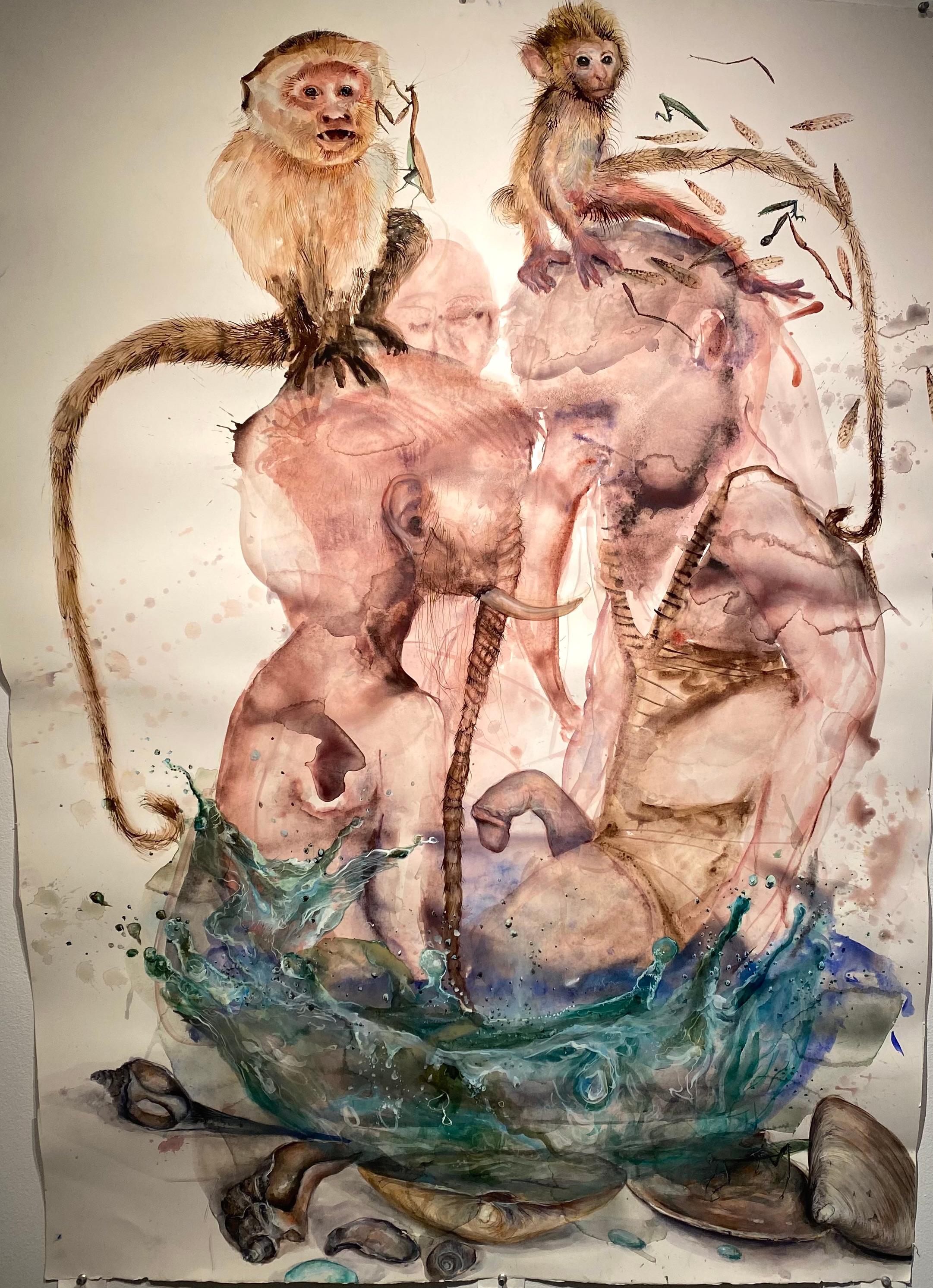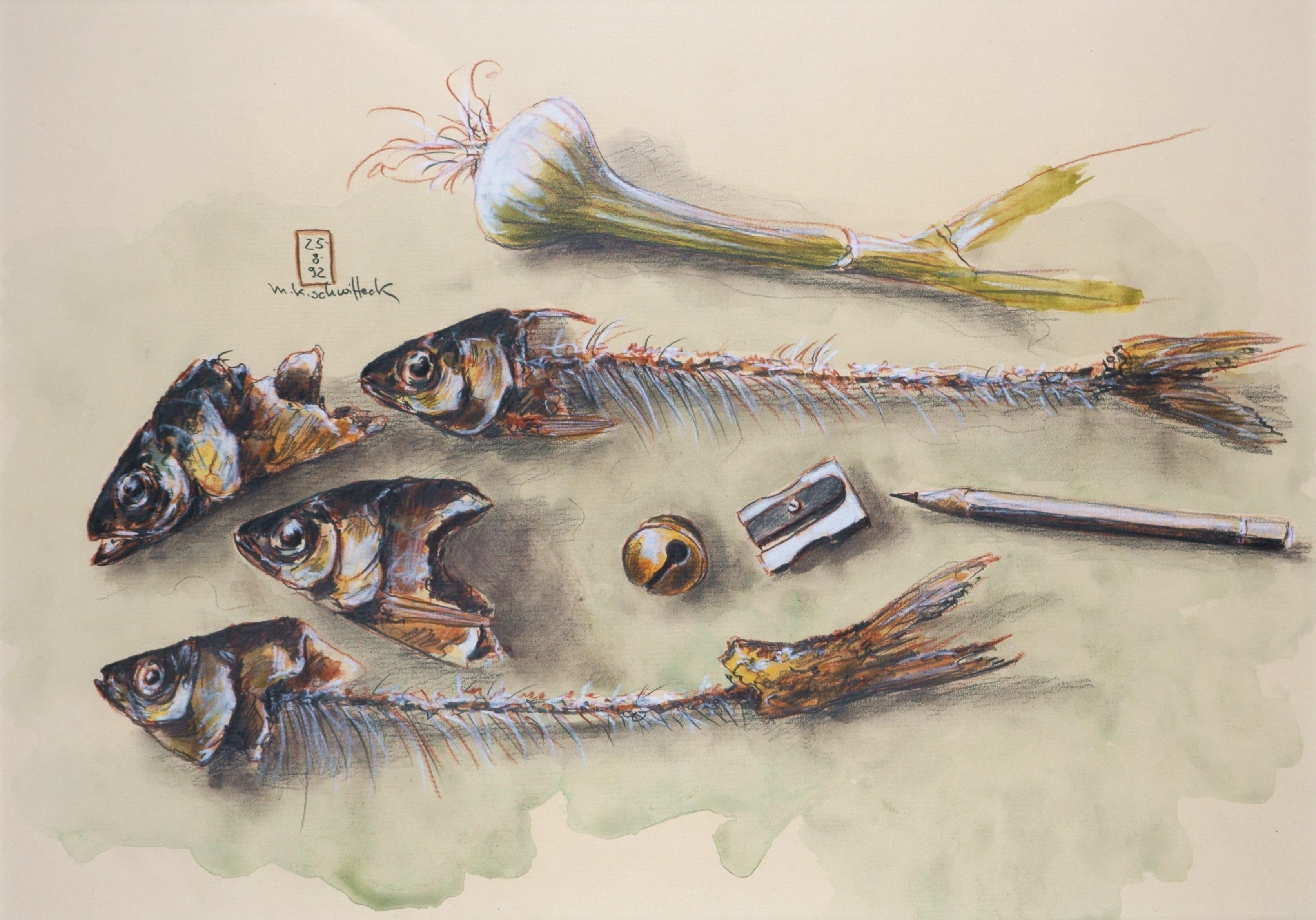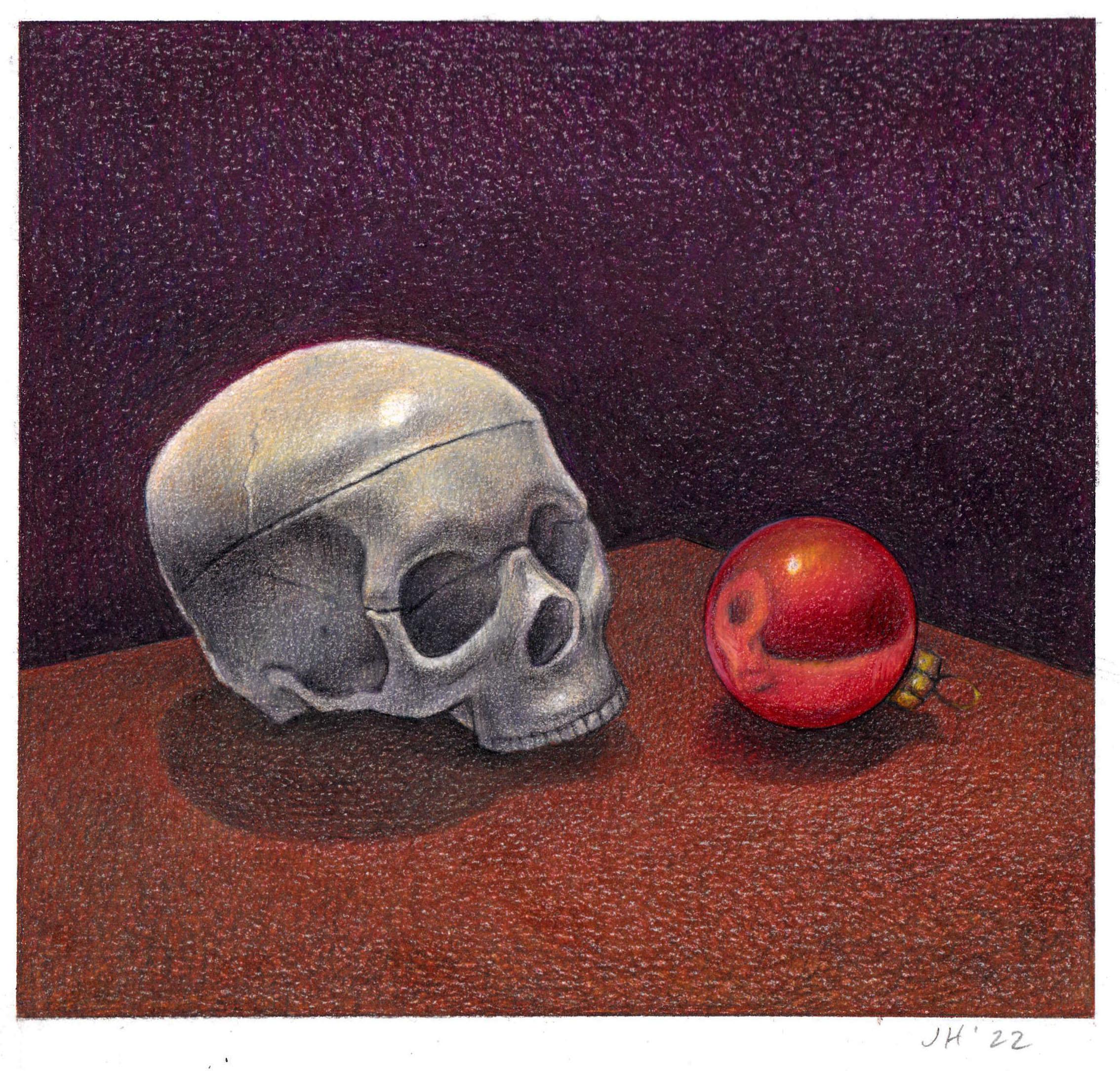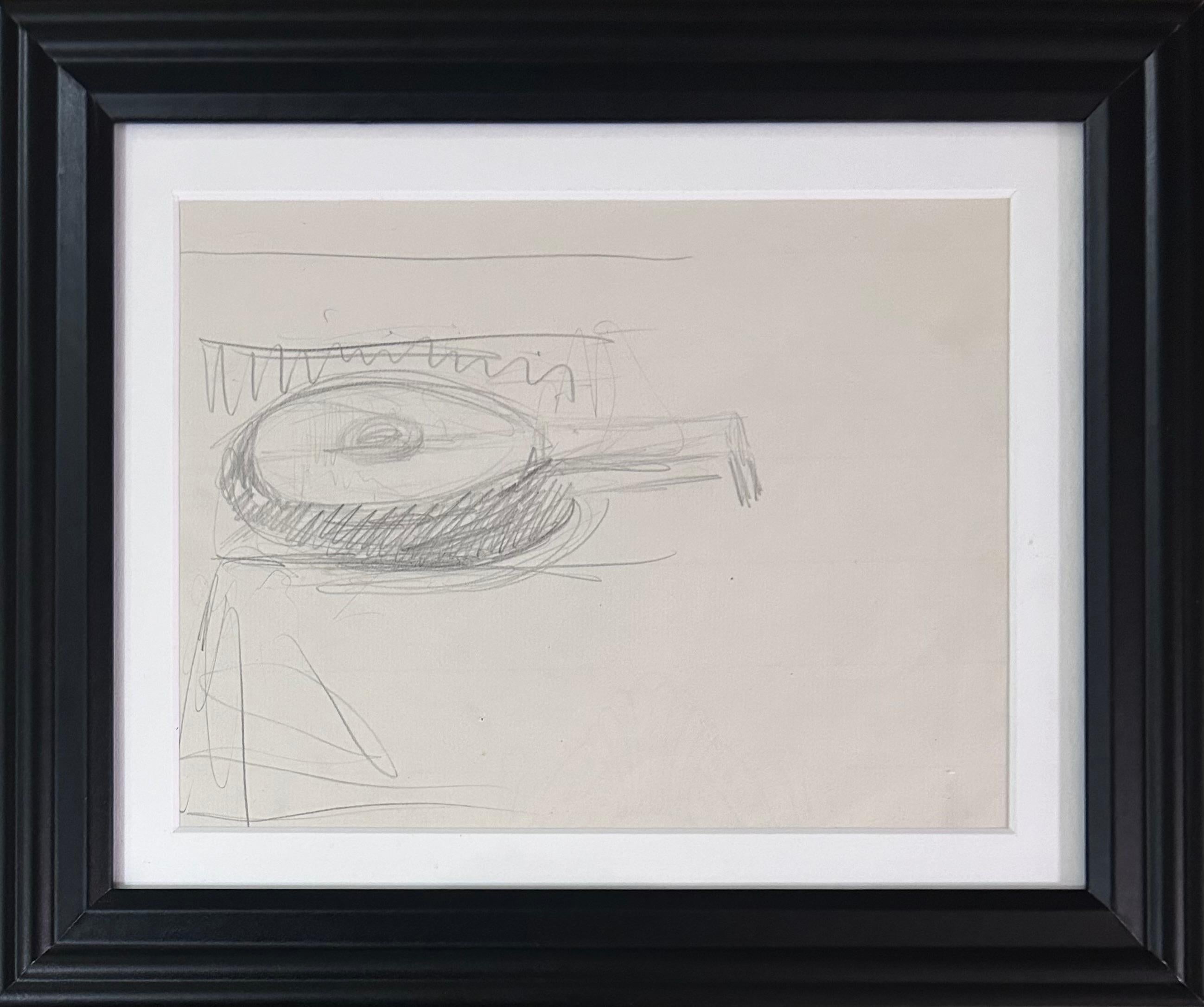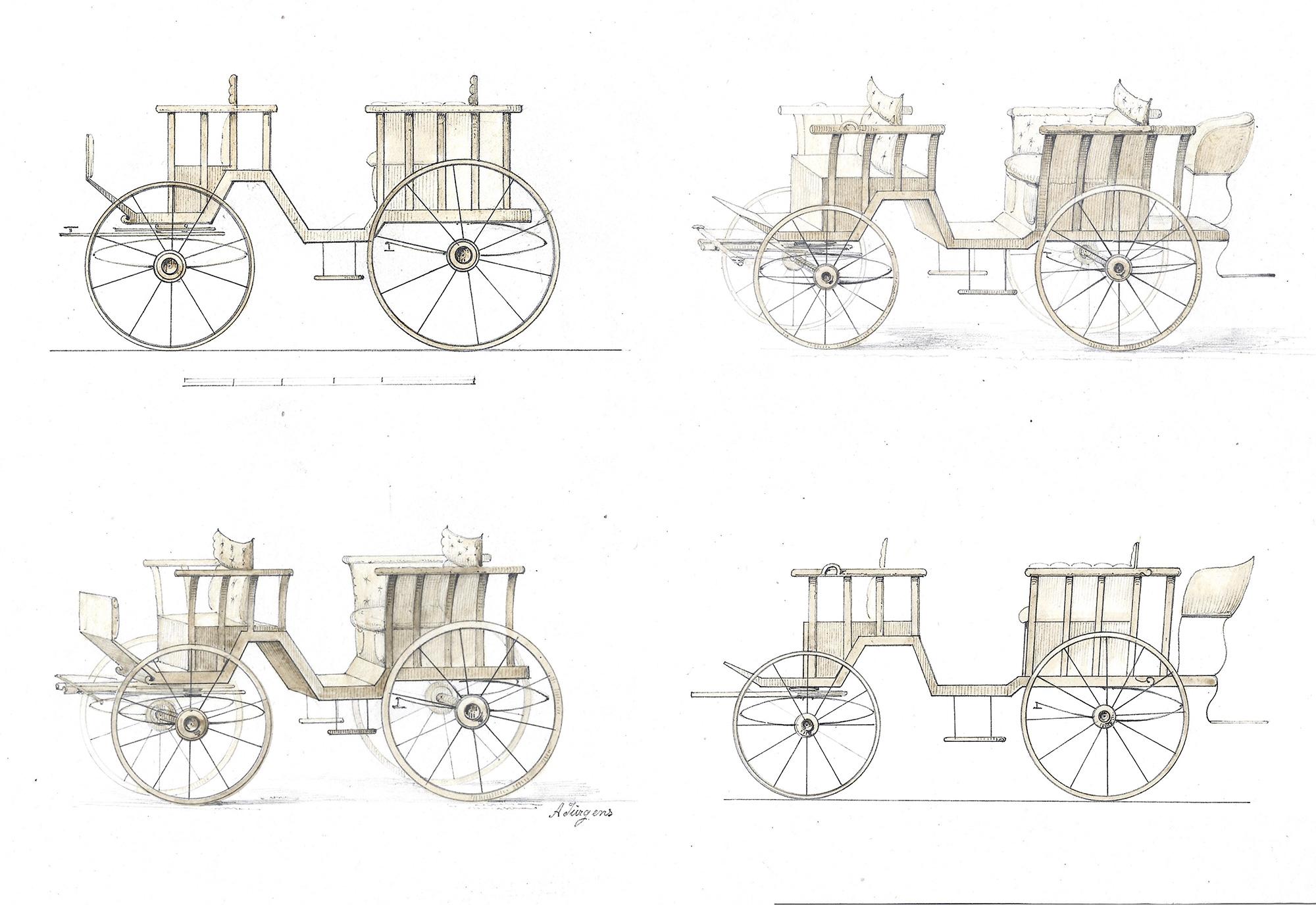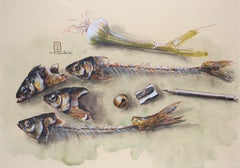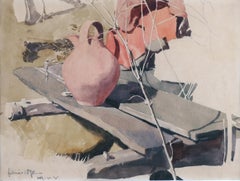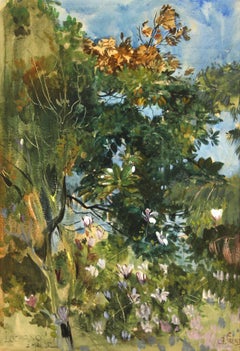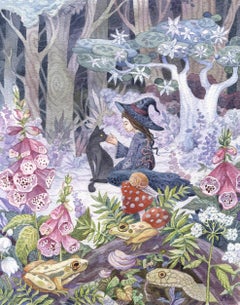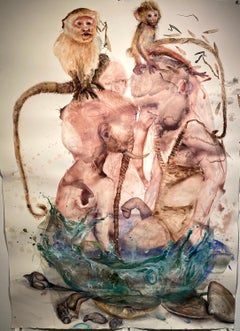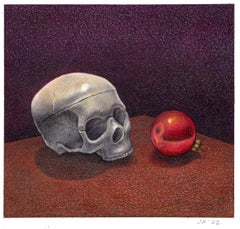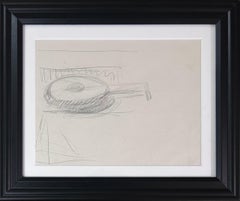Items Similar to Still life with fish bones, pencil and pencil sharpener
Want more images or videos?
Request additional images or videos from the seller
1 of 8
Manfred K. SchwitteckStill life with fish bones, pencil and pencil sharpener1992
1992
About the Item
Manfred K. Schwitteck (*1948), Still life with fish bones, pencil and pencil sharpener, 1992. watercolor over pencil on handmade paper, 31.5 x 45 cm (visible size), 47 x 61 cm (frame), signed in the center "m. k. schwitteck" and dated "25.8.[19]92", framed in passepartout under glass.
- very well preserved and attractively framed
- Die Ironie der Kunst -
About the artwork
Four remnants of consumed fish are arranged into a kind of fish shape. In the middle of this 'fish body' is a clip, a pencil sharpener and a pencil situated, above it lies a spring onion.
Manfred Schwittek creates here a still life, which has a self-reflexive dimension through the pencil and the pencil sharpener, since the picture was also drawn with the pencil. Yet the pencil is still sharpened and ready for new such creations, just as the onion could also still be prepared. The fish heads peeking out of the picture, on the other hand, are remnants, which, however, from the perspective of being artistically created, do not represent waste or leftovers, but are also something created. The bell is a humorous, as it were giggling accessory that draws attention to the contradiction between waste and art and at the same time seems to be amused by it.
GERMAN VERSION
Manfred K. Schwitteck (*1948), Stillleben mit Fischgräten, Bleistift und Anspitzer, 1992. Aquarell über Bleistift auf Büttenpapier, 31,5 x 45 cm (Sichtmaß), 47 x 61 cm (Rahmen), mittig mit „m. k. schwitteck“ signiert und auf den „25.8.[19]92“ datiert, im Passepartout unter Glas gerahmt.
- sehr gut erhalten und ansprechend gerahmt
- Die Ironie der Kunst -
zum Kunstwerk
Vier Überbleibsel verzehrter Fische sind zu einer Art Fischform angeordnet. Inmitten dieses ‚Fischkörpers‘ ist eine Schelle, ein Anspitzer und ein Bleistift situiert, darüber liegt eine Frühlingszwiebel.
Manfred Schwittek schafft hier ein Stillleben, das durch den Bleistift und den Anspitzer eine selbstreflexive Dimension aufweist, da das Bild auch mit dem Bleistift gezeichnet worden ist. Dabei ist der Bleistift noch gespitzt und zu neuen derartigen Kreationen bereit, so wie die Zwiebel ebenfalls noch zubereitet werden könnte. Die aus dem Bild herausblickenden Fischköpfe sind hingegen Überbleibsel, die unter der Perspektive des künstlerischen Geschaffen-Seins jedoch keinen Abfall oder Rest darstellen, sondern ebenfalls etwas Geschaffenes sind. Die Schelle ist ein humorvolles, gleichsam kicherndes Accessoire, das auf den Widerspruch zwischen Abfall und Kunst aufmerksam macht und sich zugleich darüber zu amüsieren scheint.
- Creator:Manfred K. Schwitteck (1948, German)
- Creation Year:1992
- Dimensions:Height: 18.51 in (47 cm)Width: 23.63 in (60 cm)Depth: 0.79 in (2 cm)
- Medium:
- Movement & Style:
- Period:
- Condition:
- Gallery Location:Berlin, DE
- Reference Number:1stDibs: LU2438212429272
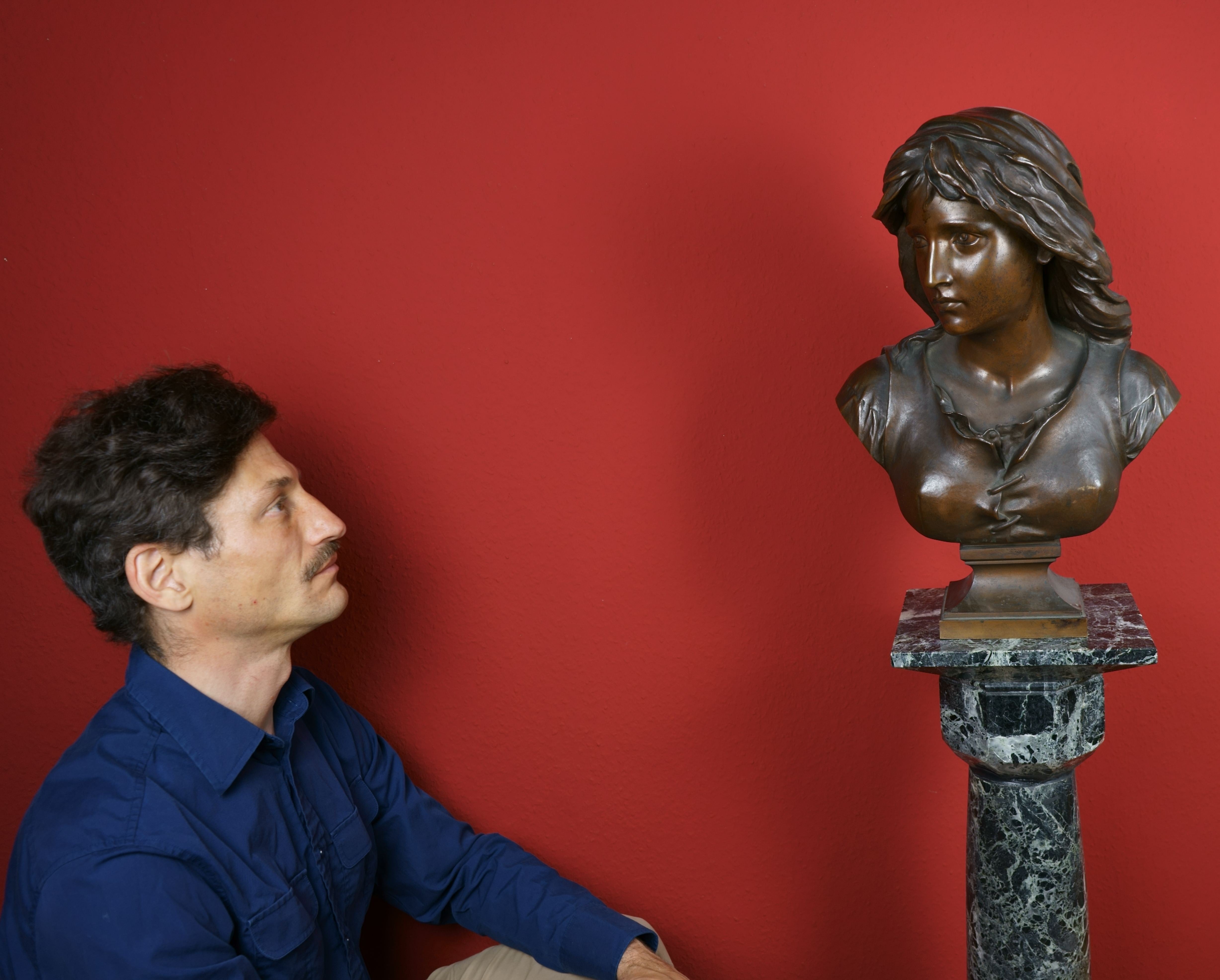
About the Seller
5.0
Gold Seller
Premium sellers maintaining a 4.3+ rating and 24-hour response times
Established in 2014
1stDibs seller since 2023
15 sales on 1stDibs
Typical response time: 4 hours
- ShippingRetrieving quote...Shipping from: Berlin, Germany
- Return Policy
Authenticity Guarantee
In the unlikely event there’s an issue with an item’s authenticity, contact us within 1 year for a full refund. DetailsMoney-Back Guarantee
If your item is not as described, is damaged in transit, or does not arrive, contact us within 7 days for a full refund. Details24-Hour Cancellation
You have a 24-hour grace period in which to reconsider your purchase, with no questions asked.Vetted Professional Sellers
Our world-class sellers must adhere to strict standards for service and quality, maintaining the integrity of our listings.Price-Match Guarantee
If you find that a seller listed the same item for a lower price elsewhere, we’ll match it.Trusted Global Delivery
Our best-in-class carrier network provides specialized shipping options worldwide, including custom delivery.More From This Seller
View AllStill life with fish bones and champagne corks / - Behind still life -
Located in Berlin, DE
Manfred K. Schwitteck (*1948), Still life with fish bones and champagne corks, 1992. watercolor over pencil on handmade paper, 31.5 x 45 cm (visible size), 47 x 61 cm (frame), signed...
Category
1990s Surrealist Still-life Drawings and Watercolors
Materials
Watercolor, Etching
Study with Torso, Hands, and Umbrella - The characteristic of the inconspicuous
Located in Berlin, DE
Paul Friedrich Meyerheim (1842 Berlin - 1915 ibid.). Sketch of a female torso with hands and an umbrella. Pencil on paper, 27.5 x 22.5 cm (visible size)...
Category
1890s Realist Figurative Drawings and Watercolors
Materials
Pencil
Clay jug on a bench - The essence of the clay jar revealed by the sunlight -
By Hans Richard von Volkmann
Located in Berlin, DE
Hans Richard von Volkmann (1860 Halle (Saale) - 1927 ibid.), Clay jug on a bench. Pencil and Watercolour on paper. 20 x 26,7 cm (visible size), 37 x 45 cm (frame), dated and monogrammed lower left "Februar 1890 - HR. V. V."
- Minimally tanned. Framed behind glass in a passepartout.
About the artwork
Using the technique of his early youth - pencil and watercolour - Hans Richard von Volkmann depicts a still life. However, this is not a conventional indoor still life, but an open-air depiction, painted outdoors and not in the studio. It is therefore an open-air painting, characteristic of von Volkmann's oeuvre, which could have been painted in the Willingshausen colony of painters, where open-air painting was programmatically practised there and the artist stayed there that year.
And indeed, this painting is a manifesto of open-air painting. Von Volkmann demonstrates that leaving the studio for the light of nature leads to an entirely new quality of art. To prove this, he uses the genre of still life, which can be described as the studio subject par excellence. Moreover, light plays an essential role in the classical still life. It is the real protagonist of the still life. And it is precisely this moment, essential to the still life, that von Volkmann exploits to demonstrate the potential of plein-air painting: He presents the objects as they appear in the sunlight. The date of February and the bare branches in the foreground make it clear that this is a clear winter day in bright sunlight. The delicate plant in the foreground casts a clearly defined shadow, as does the jug. However, the shadow is most pronounced on the jug itself: The underside of the handle appears almost black, making the top, and therefore the jug itself, shine all the more brightly. The shining of the objects in the sunlight is also visible on the bench. As complementary phenomena to the shadow zones, light edges can be seen on the boards of the seats and the upper foot of the bench shines entirely in the light. To achieve this intensity of light, von Volkmann activated the bright white of the painting ground.
By depicting the objects in glistening sunlight, von Volkmann demonstrates that this quality of light is only to be found outdoors. And this light leads to a new way of looking at the objects themselves. The jug on the bench seems like an accidental arrangement, as if the artist had stumbled upon this unintentional still life and captured it with fascination. And in this fascination there is a moment of realisation that refers to the objects themselves. It is only when they shine brightly in the sunlight that their true nature is revealed. In this way, sunlight allows the objects to come into their own, so to speak. Sunlight, which is not present in the studio, gives the still life an entirely new dimension of reality, which is also reflected in the colours interwoven by the sunlight: The bench and the jug stand in a harmonious grey-pink contrast to the green of the implied meadow.
The emphasis on the jug as the central subject of the picture also implies that the watercolour has not been completed. This non finito inscribes a processuality into the picture, making it clear that something processual has been depicted, the temporality of which has been made artistically permanent. This is why von Volkmann signed the painting and dated it to the month.
About the Artist
Von Volkmann made his first artistic attempts at the age of 14. He painted many watercolours of his home town of Halle. This laid the foundation for his later outdoor painting.
In 1880 his autodidactic beginnings were professionalised with his admission to the Düsseldorf Art Academy. There he studied under Hugo Crola, Heinrich Lauenstein, Johann Peter Theodor Janssen and Eduard von Gebhardt until 1888. Von Volkmann then moved to the Karlsruhe Academy, where he was Gustav Schönleber's master pupil until 1892.
In 1883 he came for the first time to Willingshausen, Germany's oldest painters' colony, at the suggestion of his student friend Adolf Lins...
Category
1890s Naturalistic Still-life Drawings and Watercolors
Materials
Watercolor
Plant Impression in Locarno - Floral Crescendo -
Located in Berlin, DE
Alexander Frenz (1861 Rheydt - 1941 Düsseldorf). Plant impression in Locarno. Gouache and watercolour. 35 x 23,5 cm (visible size), 49,5 x 38,5 cm (fra...
Category
1890s Impressionist Landscape Drawings and Watercolors
Materials
Watercolor
Red blooming war landscape with dead soldier - Bleeding flowers -
Located in Berlin, DE
Johannes Friedrich Heinrich Hänsch (1875-1945), Red blooming war landscape with dead soldier, 1918. Watercolor and gouache on paper, 15 x 24.5 cm (image), 27 x 37 cm (sheet size / frame), monogrammed and dated "19JH18" at lower left.
- Paper slightly darkened
About the artwork
Despite the relatively small format, the watercolor with an internal frame depicts a panoramic view of a flat landscape stretching to the horizon. As far as the eye can see, the poppies bloom in flaming red. The flowers are not rendered individually, however, creating an almost cohesive red surface. The bright red is interspersed with vegetal green. A complementary contrast that creates an intense color effect. In this color contrast, a white area breaks through from the middle ground, widening towards the foreground and surrounding a brown hole. Next to it, in blue, is the actual protagonist of the painting, the first thing that catches the eye: a dead soldier. Next to him is his helmet, revealing the empty interior. The brown, hollow shape corresponds to the hole in the ground. A shell funnel is surrounded by bright ash, which, like the inverted helmet, becomes a sign of death. The soldier's arms point to the funnel, while the empty helmet paraphrases the calotte of the skull and, like the funnel, thematizes the empty darkness of death.
The soldier's body, however, is intact and not - as in Otto Dix's triptych "The War" - a dismembered corpse. Instead, Johannes Hänsch activates the landscape, especially the color, to illustrate a blooming landscape of death that extends from the shell funnel in the foreground to the rising column of smoke on the horizon. If the soldier's body is intact, the tangle of barbed wire emblematically placed over the empty helmet also appears tattered. On the right side of the picture, the barbed wire even seems to stretch its arms to the sky in horror. Against the background of this allegory, the content of the bright red also becomes clear: the landscape is drenched in blood, literally a sea of blood, and the single unknown soldier stands pars pro toto for all those who died on the battlefield. Dying in war is not dying in community, but in solitude. In order to emphasize the isolation in death, Johannes Hänsch has set the blue of the soldier in the axis given by his body in the middle ground of the picture into the red sea.
A master of landscape painting, Hänsch succeeds in creating a natural-looking landscape allegory that illustrates the horror and death of war, without depicting the brutality of war itself. This singular 'war memorial' of the unknown soldier is the opposite of heroization and yet the dignity of the deceased soldier is preserved through the integrity of his body.
About the artist
As the son of the sculptor Adolf Haensch, the young Johannes received his first artistic training in his father's Berlin studio. However, he eventually decided to become a painter, and in 1897 he entered the Berlin Academy of Arts. He initially studied under Paul Vorgang and Eugen Bracht, and was particularly influenced by Bracht's increasingly colourful landscape painting. In 1901 he moved to the class of Friedrich Kallmorgen, with whom he spent several weeks on excursions into nature. In 1905 he became a master pupil of Albert Hertel, who taught him watercolour painting.
From 1903 to 1933 he exhibited annually at the Great Berlin Art Exhibition, the exhibitions of the Berlin Artists' Association and the Munich Glaspalast. In 1905 he was awarded the Carl Blechen...
Category
1910s Realist Figurative Drawings and Watercolors
Materials
Watercolor
Shady hollow way - Into the heart of the forest -
By Hans Dvoràk
Located in Berlin, DE
Hans Dvořák (19th century). Shady hollow way in a sunny forest. Watercolour and pen-and-ink drawing, 58.5 x 43 cm (visible size), 70 x 55.5 cm (frame), signed and dated "Hans Dvořák ...
Category
1880s Realist Landscape Drawings and Watercolors
Materials
Watercolor
You May Also Like
"Foxglove" (2024) By Ania Mohrbacher, Original Fantasy Watercolor Painting
Located in Denver, CO
"Foxglove" (2024) Is an original watercolor fantasy painting, which depicts a young witch and her black cat in the center of a clearing in a forest, rife with magical flora and fauna...
Category
2010s Surrealist Figurative Drawings and Watercolors
Materials
Watercolor, Archival Paper
Watercolor on paper: )"Monkey at Sea" (elephant nose )
Located in New York, NY
Shiri Mordechay's paintings are a whirlwind of emotion and complexity, drawing the viewer into a vibrant and dynamic world. Each piece is packed with countless details, your eyes are...
Category
2010s Surrealist Figurative Drawings and Watercolors
Materials
Watercolor, Archival Paper
Skull and Ornament - Vanitas, Still Life, Color Pencil Drawing, Framed
By John Hrehov
Located in Chicago, IL
Drawings of skulls are often called vanitas, which often contain collections of objects symbolic of the inevitability of death and the transience and vanity of earthly achievements and pleasures; it exhorts the viewer to consider mortality and to repent. This still life vanitas drawing is matted with a heavy white mat and framed in a bronze toned wooden frame measuring 15.75 x 16.25 inches.
John Hrehov
Skull and Ornament
colored pencil on paper
7h x 8w in
17.78h x 20.32w cm
JHR006
John Hrehov
Education
1985 MFA-Painting, University of Illinois at Urbana-Champaign
1981 BFA-Painting, Cleveland Institute of Art, Cleveland, OH.
Solo Exhibitions
2017 John Hrehov, Paintings and Drawings. Tom Thomas...
Category
2010s Surrealist Still-life Drawings and Watercolors
Materials
Archival Paper, Color Pencil
Mandolin - Unique Drawing Pencil on Paper Hand Signed Surrealism, 1930
By Salvador Dalí
Located in New York, NY
Salvador Dalí
Mandolin, ca. 1930
Graphite on paper
6 × 8 in l 15.2 × 20.3 cm
Frame included - 11 x 13 in l 28 x 33 cm
The authenticity of this artwork has been confirmed by Mr. Desc...
Category
1930s Surrealist Figurative Drawings and Watercolors
Materials
Graphite
$6,650 Sale Price
30% Off
Kutschen (carriages); Group of four designs for hansom cabs.
By Alfred Juergens
Located in Middletown, NY
Four pencil drawings, each with hand coloring in watercolor, each 6 3/4 x 10 inches (sheet) (172 x 254 mm), full margins. Each with inscriptions and notations by the artist in the up...
Category
Mid-20th Century American Modern Still-life Drawings and Watercolors
Materials
Handmade Paper, Watercolor, Pencil
Collection of Watercolour Designs for Silverware.
Located in London, GB
[ANON.]
Collection of Watercolour Designs for Silverware.
South Germany, [Late 19th century].
A series of 9 watercolours, each framed and glazed, ...
Category
Late 19th Century Figurative Drawings and Watercolors
Materials
Watercolor, Paper, Pencil
Recently Viewed
View AllMore Ways To Browse
Life Size Head
Dior 1992
Fish Artwork
Still Life With Fish
Still Life With Fishes
Fish Head
Picture Frames Under Glass
Fish Bone
Glass Onion Vintage
Pencil Sharpener Vintage
Liz Rodgers
Mollie Foster
Watermelon Gothic
Original Art For Sale
Still Life Mid Century Art
New York Expressionist Painting
Original Japanese Art
Love Edge

